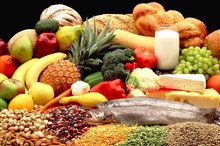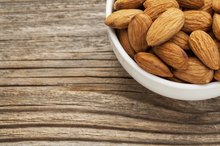How Much Should a 13-Year-Old Girl Eat?
When you’re a girl entering your teen years, eating a well-balanced diet is an easy way to boost your daily energy and improve your health while increasing your chances of reaching your ideal height and weight. But you may not know what “well-balanced” really means. To make sure you’re eating the right amount of the right foods, focus on eating the serving sizes recommended for 13-year-old girls by the U.S. Department of Agriculture.
Vegetables
As a 13-year-old girl, you should be eating about 2 cups’ worth of vegetables every day. A 1-cup serving of vegetables is equivalent to about 1 cup of broccoli florets, 2 cups of raw leafy green vegetables such as spinach, 1 cup of cooked leafy greens or two medium carrots. Although many vegetables have nutritional value, some of the healthiest are the brightest in color. Red bell peppers, bright orange carrots and dark green vegetables such as spinach all fall under that umbrella.
- As a 13-year-old girl, you should be eating about 2 cups’ worth of vegetables every day.
- A 1-cup serving of vegetables is equivalent to about 1 cup of broccoli florets, 2 cups of raw leafy green vegetables such as spinach, 1 cup of cooked leafy greens or two medium carrots.
Fruits
What Is a Balanced Diet for a Growing Teenage Boy or Teenage Girl?
Learn More
Aim for at least 1 ½ cups of fruits every day. A 1-cup serving of fruit equals about one large banana or peach, 1 cup of 100-percent juice or ½ cup of dried fruit. Fruits are rich in nutrients such as potassium, fiber and vitamin C, but fruit juice has had its fiber removed. Because fiber improves your digestion and can help keep your stomach full, most of your fruit servings should come from fruit rather than juice, according to KidsHealth. If you eat canned fruit, eat the kind that is canned in juice instead of sugary syrup.
- Aim for at least 1 ½ cups of fruits every day.
- Because fiber improves your digestion and can help keep your stomach full, most of your fruit servings should come from fruit rather than juice, according to KidsHealth.
Grains
You need about 6 oz. of grains per day, but at least half of your grains servings should be whole rather than refined because whole grains still have their fiber and all of their nutrients. Examples of refined grains are white rice and white bread. Examples of whole grain foods are oatmeal, air popped popcorn, quinoa and whole grain spaghetti. To get your daily 3 oz. of whole grains, you could start your day with a bowl of oatmeal, make your lunch sandwiches on wheat bread and ask your parents to serve brown rice with dinner.
- of grains per day, but at least half of your grains servings should be whole rather than refined because whole grains still have their fiber and all of their nutrients.
- Examples of whole grain foods are oatmeal, air popped popcorn, quinoa and whole grain spaghetti.
Protein
5 Main Types of Healthy Food
Learn More
You should eat about 5 oz. of protein per day. Protein comes from animal products such as poultry and fish, but you can still get plenty of protein in your diet if you’re a vegetarian because foods such as beans, peas, tofu, nuts and seeds are also full of protein. A 1-oz. serving of protein equals about one egg, 1 tbsp. of peanut butter, 1/2 oz. of nuts and 1 oz. of poultry or fish.
- You should eat about 5 oz.
- serving of protein equals about one egg, 1 tbsp.
Dairy
You need about 3 cups of dairy each day to grow properly. A 1-cup serving of dairy equals about one 8-oz. container of yogurt, 1/3 cup of shredded cheese, 1 cup of milk or 2 cups of cottage cheese, according to the U.S. Department of Agriculture. Some foods that are dairy aren’t a part of the dairy group because they contain little or no calcium. These foods include cream cheese and butter. If you can’t digest dairy, foods such as calcium-fortified juices and soy milk can help you get enough calcium to grow well.
- You need about 3 cups of dairy each day to grow properly.
- Some foods that are dairy aren’t a part of the dairy group because they contain little or no calcium.
Fats
You should usually stick to lean proteins and low-fat or skim dairy foods. The fattier versions of these groups are higher in saturated fat, which can contribute to heart disease if you eat too much of it. Because you still need some fats in your diet, though, you may be wondering where you can find them. Stick to oils, which stay liquid when they are at room temperature. Many healthy oils, such as vegetable and olive oil, are often used in cooking. Oils are also in many fish and plant foods such as nuts, olives, avocados and seeds. Aim for about 5 tsp. of oils a day.
- You should usually stick to lean proteins and low-fat or skim dairy foods.
- The fattier versions of these groups are higher in saturated fat, which can contribute to heart disease if you eat too much of it.
Related Articles
References
- Center for Young Women’s Health: Healthy Eating
- Weight-Control Information Network: Take Charge of Your Health: A Guide for Teenagers
- Mayo Clinic: Nutrition for Kids
- Linus Pauling Institute. α-Carotene, β-carotene, β-cryptoxanthin, lycopene, lutein, and zeaxanthin.
- U.S. Department of Agriculture. Why is it important to eat vegetables?
- Rasmussen HM, Johnson EJ. Nutrients for the aging eye. Clin Interv Aging. 2013;8:741‐748. doi:10.2147/CIA.S45399
- Sangiovanni JP, Chew EY, Clemons TE, et al. The relationship of dietary carotenoid and vitamin A, E, and C intake with age-related macular degeneration in a case-control study: AREDS Report No. 22. Arch Ophthalmol. 2007;125(9):1225-32.. doi:10.1001/archopht.125.9.1225
- Wu J, Cho E, Willett WC, Sastry SM, Schaumberg DA. Intakes of lutein, zeaxanthin, and other carotenoids and age-related macular degeneration during 2 decades of prospective follow-up. JAMA Ophthalmol. 2015;133(12):1415‐1424. doi:10.1001/jamaophthalmol.2015.3590
- Linus Pauling Institute. α-Carotene, β-carotene, β-cryptoxanthin, lycopene, lutein, and zeaxanthin.
- Carneiro Â, Andrade JP. Nutritional and lifestyle interventions for age-related macular degeneration: A review. Oxid Med Cell Longev. 2017;2017:6469138. doi:10.1155/2017/6469138
- Evans JR, Lawrenson JG. Antioxidant vitamin and mineral supplements for slowing the progression of age-related macular degeneration. Cochrane Database Syst Rev. 2017;7(7):CD000254. doi:10.1002/14651858.CD000254.pub4
- National Eye Institute. Nutrition supplements for age related macular degeneration. Updated April 7, 2020.
- Merle BM, Silver RE, Rosner B, Seddon JM. Adherence to a Mediterranean diet, genetic susceptibility, and progression to advanced macular degeneration: a prospective cohort study. Am J Clin Nutr. 2015;102(5):1196‐1206. doi:10.3945/ajcn.115.111047
- American Heart Association. What is the Mediterranean diet? Updated: January 9. 2020.
- de Souza RGM, Schincaglia RM, Pimentel GD, Mota JF. Nuts and human health outcomes: A systematic review. Nutrients. 2017;9(12):1311. doi:10.3390/nu9121311
- National Institute of Health. Omega-3 fatty acids. Updated: July 11, 2019
- Romani A, Ieri F, Urciuoli S, et al. Health effects of phenolic compounds found in extra-virgin olive oil, by-products, and leaf of Olea europaea L. Nutrients. 2019;11(8):1776. doi:10.3390/nu11081776
- American Macular Degeneration Foundation. Recommended supplements for age-related macular degeneration.
Writer Bio
Christa Miller is a writing professional with expertise in massage therapy and health. Miller attended San Francisco State University to earn a Bachelor of Arts in creative writing with a minor in journalism and went on to earn an Arizona massage therapy license.









